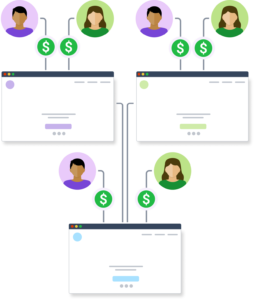A Guide to Peer-to-Peer Fundraising


When you’re part of a competitive marketplace and trying to fund helpful projects that benefit communities, it’s paramount that your nonprofit organization employs all of the tools available.
While traditional fundraising may be the biggest hammer in your bag, one of the newest additions to the nonprofit toolbelt, peer-to-peer fundraising, has been making itself more and more useful over the last decade. So useful, in fact, that if your nonprofit isn’t employing a peer-to-peer (P2P) fundraising strategy, your bottom line may be missing out.
But there’s a good chance your nonprofit isn’t aware of peer-to-peer fundraising; this study found that 40% of nonprofits don’t even know what it is. So what is it?
What is Peer-to-Peer Fundraising?
Peer-to-peer fundraising is any fundraiser where your supporters raise money from their own networks to fundraise on your behalf. It’s a multi-tiered model that takes advantage of social media to spread your message throughout social networks to reach as many people as possible.
A peer-to-peer fundraising campaign can take many different forms but the most common ones that you’re likely to have seen advertised or even participated in, according to this study, are bicycle events, endurance events, walks, and 5 km runs. Other P2P fundraising efforts include workplace events and viral social media fundraisers (more on these later).
P2P fundraisers are often organized by a nonprofit that registers supporters to participate; participants then ask their own networks for donations and those funds are fed back to the nonprofit.
It takes the burden of asking for donations off the shoulders of the nonprofit and puts it onto people who believe in your cause. In this way, your message reaches many more people than a traditional fundraising campaign might.
You may have come across the term “crowdfunding” as well. Crowdfunding refers to an individual or organization asking for many small donations from a large number of donors, rather than just one or two large donations.
While P2P fundraising can be considered crowdfunding in some cases, it is much more extensive and accesses many networks. Ultimately, when raising money via P2P, the key is that the actual asking is done by a large number of supporters, not your organization.
Who Uses Peer-to-Peer
Fundraising?
Simply put, not everyone. Not even close. One study found that in 2017, 41% of nonprofits had not utilized any type of P2P fundraising. That means there is still a lot of opportunities to get in on the action.


Demographic studies from several years ago spent a lot of time trying to figure out who your message is likely to reach online when you embark on a P2P campaign. The truth is, in 2020, nearly everyone in the developed world and much of the developing world is online. Even your grampa is on Facebook now.
That means that if your mission resonates with people, you have a compelling message, and your supporters are willing to spread the word, the number of people you can reach is staggering compared to years past.
Why is P2P Important?
The nonprofit landscape is changing. It’s diversifying. And it’s happening quickly.
Gone are the days of “if you build it, they will come.” Good work isn’t enough. And the statistics suggest that fewer donors are giving each year. So reaching as many people as possible via P2P is now hugely important for the continued success of your organization.
The Benefits of P2P
The P2P fundraising model offers a host of benefits including:
P2P fundraisers help keep supporters engaged by galvanizing them around a single event with a clear message and goals. Your organization can reach new donors through the power of social networks and viral sharing. Social sharing buttons can turn a campaign 3 people know about, to 3,000.
Your most enthusiastic supporters can become ambassadors for your cause, campaigning on your behalf year-round. Compared to the costs of traditional fundraising, P2P fundraising requires less money and utilizes fewer resources. Fun events tend to bring back participants year after year. As more people share your message, your brand gets a visibility boost and it becomes easier and easier to raise funds each year.
Peer-to-Peer Fundraising Events
As mentioned earlier, the most common form of P2P fundraising is an event like a bike ride or fun run. But there are all sorts of P2P events that can help raise more money for your nonprofit, and not all of them make you sweat.
Types of P2P Events
- Online Campaigns, like Giving Tuesday, are amazing because, rather than organizing a lot of people in a physical location with the associated costs and logistical issues, sharing itself is the event. People give on Giving Tuesday because it happens to be that day and they’re on Facebook, not because they rode a bike 100 km after months of training. The barrier to entry is low and visibility can be very high and far-reaching.
- Live events, like bike rides and runs, have been successful because they link your cause with something that people already like to do, so convincing people to participate is less arduous than simply asking for donations. This study found that cyclists tend to raise more money and use online tools better than other event participants, so it might be time to get out your stretchy shorts.
- Team or workplace fundraisers capitalize on pre-existing groups that are often committed to a common cause. Ask office mates or team members to donate as well as solicit donations from their networks. Just a few ideas: company golf tournament, chili cookoff, scavenger hunt, or bowl-a-thon. Boost your reach by encouraging competition between office divisions or even between companies.
- DIY fundraising includes a wide variety of online fundraiser ideas created by individuals, such as dedicating your birthday on Facebook to a particular cause and soliciting donations. This is one of the lightest weight options out there since it requires almost no administration, and online tools, like Facebook Fundraisers, are increasingly available for free or a small service fee.
- For an added bonus, make the most of your fundraising efforts by finding a corporate donor to match gifts as part of your campaign. A committed corporate partner could double your bottom line for an event with just a phone call or email to start the conversation.
Getting started
Starting your P2P campaign is straightforward and reasonably easy to achieve in a short time on a modest budget. This post on Beth Kanter’s blog is filled with tips on how to get started but the basic steps are:
1. Set your fundraising goals: Think big but not too big. Smaller, regional events will draw fewer people than massive online campaigns, but remember that your online push won’t necessarily go viral and a smaller event may grow year after year thanks to loyal participants.
2. Choose a platform: Take the time to do your research and find a peer fundraising platform that meets your needs and works with your existing resources.
3. Recruit participants: Your first round of recruits will be your ambassadors. From them, your message will be shared and spread through multiple networks.
4. Create fundraising pages: Your participants will create their customized fundraising pages explaining why they are joining your event, what your cause means to them, etc. Remember that a picture is worth a thousand words, so encourage everyone to use images and video!
5. Share with supporters’ networks: Participants share their peer fundraiser pages on social media, where people will (hopefully!) see them, donate, and perhaps join your cause as well.
6. Track performance: Monitor the number of participants, incoming donations, and any other pertinent peer-to-peer fundraising statistics to establish a baseline for next year.
Three Successful P2P Fundraisers
The internet is littered with P2P fundraisers that failed to achieve the success that their organizers hoped for, and there is usually one reason for that: they didn’t tell a great story.
A compelling story is the special sauce that is the difference between a campaign that fizzles and one that goes viral. Start by brushing up on your storytelling, then check out the following well-known examples to see how they made it happen.
1. Terry Fox Run
Terry Fox was a young Canadian who was diagnosed with cancer and had his leg amputated. To raise money to find the cure, he began The Marathon of Hope and attempted to run across Canada, only to be defeated by the disease before he could finish. It was front-page news in 1980, and the story still motivates people today. Since then, people around the world have taken up his cause at annual running events, raising millions for cancer research.
2. ALS Ice Bucket Challenge
A relatively low profile disease before 2014, ALS became perhaps the best example of a viral phenomenon ever when a few guys decided to dump icy water on their heads to cheer up a family member with the disease, and pledged to donate to find a cure while nominating others to do the same.
The ALS Association found that “more than 17 million people [in 2014] uploaded their challenge videos to Facebook” and those videos were “watched by 440 million people a total of 10 billion times.” This is proof that your story doesn’t have to be long or sad or even full of details to motivate people. The Ice Bucket Challenge is a perfect example of a DIY fundraiser. When it began, the ALS Association wasn’t involved. It was started by an amateur golfer on Facebook.
3. Movember
Every November, clean-shaven men around the world put their razors away and try their best to grow a soup strainer in just one month, posting photo updates along the way in exchange for donations to prostate cancer, testicular cancer, mental health, and suicide prevention. Movember’s story is unique to each participant—while the creation of Movember may be interesting, the true epic is watching your friends,
Reach Further and Raise More with Keela’s Peer-to-Peer Fundraising Tool
What’s stopping you from trying peer-to-peer fundraising?
If you’re still unsure, start small and build from there in the years to come. If you’re 100% convinced, plan something big and find yourself some committed ambassadors who will help shout your message as loud, clear, and far as they can. And if you’re going to participate, don’t forget to give to your own campaign!
With Keela’s Peer-to-Peer fundraising tool, you can reach and engage a wider network of donors and supporters. This tool allows your supporters to fundraise on behalf of your nonprofit. Using Keela’s highly customizable peer-to-peer fundraising pages and optimized donation forms, your supporters can spread the word about your campaign, raise money and track their progress. Such a collective effort goes a long way to helping your organization meet its fundraising goals.


Reach More Supporters with Keela’s Peer-to-Peer Fundraising Tool
Your supporters can now fundraise with you! Using Keela’s NEW peer-to-peer fundraising tool, supporters can create and share customizable fundraising pages to raise money for your nonprofit’s campaigns.







